To get infected, a sip of water from the stream was enough. No wonder this disease spread with incredible speed. It decimated the poor, but it also killed crowned heads. Who fell victim to it and should we still be afraid of it?
In the 21st century, has anyone heard of typhus fever? Perhaps some will vaguely recall references to fiction or history textbooks. Typhoid, as it is called today, was distinguished as a separate entity only in the mid-nineteenth century. However, it has been known to mankind for a long time. It belongs to the so-called "dirty hands diseases", which are most often transmitted through food after the infectious agent gets into food due to lack of proper hygiene.
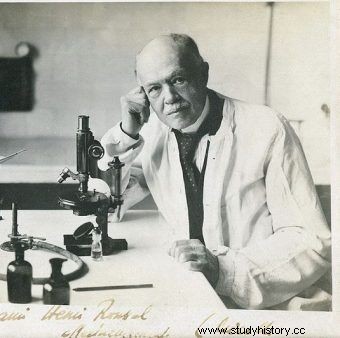
The cause of the spread of typhus was identified only in the 20th century by Charles Nicolle.
Typhus has plagued mankind for centuries. He took a great toll in wars, as "camp fever", on ships ("ship fever") or in prisons ("prison fever"). Those infected complained of severe abdominal pain, high fever, diarrhea, and delirium . Especially the latter symptom distinguished this ailment from other infectious diseases. Józef Orkisz, a doctor and surgeon operating in Warsaw and Lviv, wrote in a work devoted to typhoid published in 1875:
She got her surname, it seems, from a symptom of everyone who falls into the eyes of the subject, namely some intoxication or dullness of the sick person's mind. In our country it was known in the old days under the name of bedrock, probably because a sick person with this fever was forced to lie for a few weeks.
"One sick person infects hundreds of healthy ..."
At the time this text was written, the culprit of the disease was already known. In 1874, the typhoid fever Salmonella typhi Another Polish physician, Tadeusz Browicz, professor of the Jagiellonian University, discovered in the spleen of a deceased patient. Unfortunately, despite the recognition of the enemy, the number of cases remained high for many decades. Because it was extremely easy to get infected. It was enough to drink dirty water, eat unwashed fruit or vegetables or come in contact with the sick person.
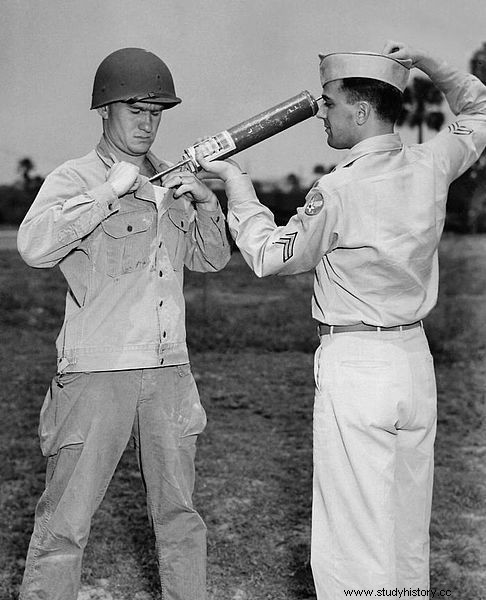
Typhus was called "camp fever" or "prison fever". The photo shows American soldiers using equipment to eradicate the population of lice transmitting typhus.
"One sick person infects hundreds of healthy people, it can infect water, milk, clothes" - warned already in the 20th century, another Polish doctor, Antoni Puławski. This is what happened with Mary Mallon, the famous "Typhus Mary". She was a carrier of typhoid bacteria, although she herself was not ill. And because she worked as a cook, the chopsticks got into the food she prepared. Ot was in a hurry with the meal, did not wash her hands thoroughly after leaving the toilet - and the tragedy is ready . The result was family epidemics in her employers in the first decade of the 20th century.
After the problem was identified, the woman was accused of spreading a then deadly disease and placed under quarantine. Not only did she have to regularly provide blood, urine and stool samples for tests, but also show doctors how to wash her hands:
They wrapped her tightly to watch, so she started washing her very slowly, rubbing a bar of soap on the back of her hands, then inside them and between the fingers, not at all taking your time (unlike when she had to worry about getting dinner on the table at the appointed time). She wiped her hands on a hand towel hanging next to the sink, which they were also watching closely.
Cases like Mary Mallon are not unique. Every year more people in the world die from infectious diseases than from natural disasters! And this is in the 21st century, in peacetime…
Durem to the front
War has completely different rules. The outbreak of an epidemic for centuries has been able to torpedo the plans of the best commanders and stop the most powerful armies. Typhoid fever has accompanied armed conflicts since the beginning of mankind. It already harassed the ancients, and in the Middle Ages it decimated, among others, the Crusaders in the Holy Land. He also captured the army of Emperor Henry IV Salicki, putting an end to his bold aspirations to capture Rome.
This deadly disease was also known to soldiers from the times of the Napoleonic campaigns, the Crimean, Spanish-American and Civil War. Especially during the last one, which took place in the USA in 1861-1865, typhus took a deadly toll. About 80,000 cases of typhoid fever have been counted in the ranks of the Union. Almost 30,000 soldiers have died! Due to the numerous cases of the disease n Some regiments were even called "typhus" .
A similar situation repeated four decades later, during the Boer Wars in South Africa in 1899-1902. More than 70,000 British soldiers and many Boers fell ill with typhoid fever. In just two years, between 1900 and 1902, more than 40,000 soldiers became infected. 11,000 did not survive. For comparison, less than 6,500 British people died in the fighting at the same time.
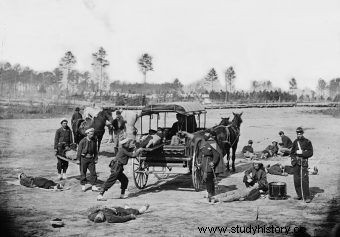
The disease took its toll in many wars. The photo shows a horse-drawn carriage during the Civil War.
The Boers, imprisoned in British concentration camps, also struggled with typhus. The symbol of colonial oppression was Lizzie van Zyl, a girl interned in the Bloemfontein camp . She fell ill due to malnutrition and poor sanitation. When she died, she was only seven years old! Thanks to her moving photography, the whole world has known her. In addition, 30,000 Boer women and children died in captivity.
"How can I protect them?"
Doctor Puławski, in his work devoted to infectious diseases published just after the First World War, emphasized that compliance with sanitary recommendations "is particularly difficult in times of war and the then poverty, hunger and high prices". After all, it is difficult "to get a piece of soap, to change underwear more often". The doctor asked rhetorically how the state should protect soldiers from falling ill:
drunk with long marches to avoid drinking water contaminated with typhus, dysentery (bloody diarrhea) or cholera, how to prevent them from staying overnight in an infected town, eating an infected one food and other things?
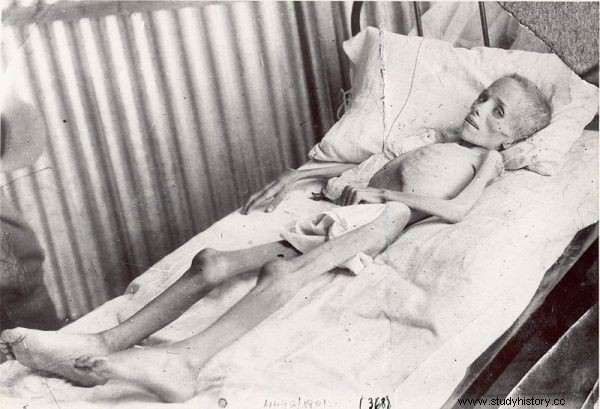
Lizzie van Zyl was a Boer girl who died of typhoid fever in a British concentration camp.
The response of medicine was vaccines. At that time, Polish soldiers received protective injections against typhoid, cholera and smallpox. Puławski reports that around 100,000 recruits were protected against typhus at that time. The effect was that:
among the legionnaires - whether in the Carpathians, Galicia, Hungary and Bukovina, or in the Kingdom of Poland or Volhynia - there were only single cases of typhus, and death from this disease was one of the exceptions; and at the same time, among the unvaccinated local population with whom our soldiers came into contact, there was a lot of typhus and the mortality rate was high.
Reading between the lines - vaccinated soldiers passed the disease more easily. But they infected God with the spirit of innocent civilians wherever they dragged them…
Simple workers and crowned heads
Who was most at risk of contracting typhoid? For centuries, he was a regular guest, especially where there was hunger, poverty or war turmoil. He also accompanied the emigrants. The germs traveled with the colonists to the New World, where they killed more than 6,000 settlers in the first years of the 17th century.

Typhus spread with the soldiers fighting in the War of the Austrian Succession. One of the battles of the conflict is shown in the picture - the Battle of Fontenoy.
More than a hundred years later, more large outbreaks of typhus appeared in Europe. In the 1840s, it killed about 55,000 people in northwestern France. It also decimated the population of southern and western Germany. Soldiers who fought in the War of the Austrian Succession of 1740-48 dragged her as far as Bohemia and Silesia.
Later, in the mid-nineteenth century, typhoid fever decimated the Indonesian Peninsula. Almost all the inhabitants of Java fell ill! One third of those infected in 1846 died. One year later - almost half.
As early as the beginning of the last century, the British Columbia epidemic of 1908-13 claimed hundreds of lives among the inhabitants of the Rocky Mountains. Railway workers brought the disease there. At the same time, in the first decades of the twentieth century, it successfully torpedoed the company with yellow fever and malaria for almost half a year of the construction of the Panama Canal.

Typhoid vaccine prof. Rudolf Weigl at the Museum of the History of Polish Jews in Warsaw
And although you might think that the fever march is a relic of past eras, nothing could be more wrong. It was still feared after the Second World War. It took control of, among other things, post-war Italy, devastated by air raids and bombing. Tens of thousands of people contracted typhus there in 1943-49. Later, in the 1950s, poor sanitation, famine and the floods that swept the country brought the epidemic back. Many thousands of people died. The number of cases at the end of the tragic decade is estimated at over 100,000.
But Salmonella typhi sticks for centuries they had killed not only poor people suffering from hunger. Their victims were also famous people from high society. In 1612, they led to the death of Henry Frederick Stuart, the eighteen-year-old heir to the English throne. Two and a half centuries later, they were the cause of the death of Albert, the forty-two-year-old husband of Queen Victoria. Also, Abigail, wife of President John Adams, 11-year-old Willy, son of Abraham Lincoln, and mother of Theodore Roosevelt died because of them.
Typhoid fever also ended the career of one of Wright's brothers, Wilbur, in 1912, after he ate infected mollusks at a party. Less than two decades later, he caught up with the writer Arnold Bennett, who drank tap water in a restaurant in Paris ... to prove that it was safe.
Is it possible to win completely?
While the doctors were worrying about what to do with the case of "Typhus" Mary Mallon, a typhoid epidemic broke out in New York, perhaps because of her. About 3,000 people fell ill. At that time, at the beginning of the 20th century, he had not yet been treated with antibiotics. Even vaccines were still tested before the First World War. Initially, these were preparations made from horse blood . One of the heroes of the book by Mary Beth Keane "Fever" says:
They inject the horses with disease germs and wait for the animal to fight them, then take blood from it and leave only plasma with these anti-disease bodies to feed people to injections.
In fact, this method did not give one hundred percent certainty. Dr. Edith Claypole, a doctor who prepares vaccines for soldiers going to the front, found out about this. In 1915 the woman, although she had undergone the procedure herself, fell ill and died. Another physician, Hakaru Hashimoto, the discoverer of the disease named after him, was also victimized in 1934.
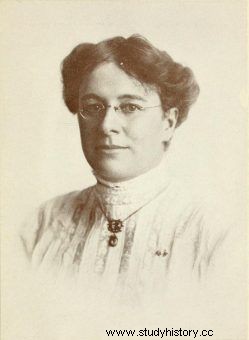
Edith Claypole created vaccines for soldiers going to the front of the First World War. She paid for her work with her life.
In Poland, typhoid was one of the most common infectious diseases until the middle of the last century. Protective vaccinations, carried out by the National Institute of Hygiene, were introduced on a larger scale only after independence was regained. Thanks to them, and also thanks to the improvement of sanitary conditions, the process of fever which in the years 1919-1924 killed almost 10,000 Poles was stopped . The fight continued without stopping. In Łódź alone, over 72,000 inhabitants were vaccinated by 1928.
We had another epidemic right after the Second World War. Fortunately, in 1948 the death toll was much smaller than before. Less than 500 people died, although almost 8,000 fell ill. Widespread vaccination of children and adolescents has almost eliminated the threat. Since the 1970s, this deadly disease has been fading away.
Bibliography:
- Włodzimierz Berner, From the history of fighting acute infectious diseases in Poland after World War I - until 1924 , "Przegląd Epidemiologiczny", No. 62 (2008).
- Frederick Cartwright, Michael Biddiss, The unseen enemy. Pests and History , Wołoszański Publishing House 2005.
- Encyclopedia of Plague and Pestilence. From Ancient Times to the Present , ed. George C. Kohn, Infobase Publishing 2008.
- Paweł Gantkowski, The essence of the plague and the view of the fight against infectious diseases in times of war , Printing House and Bookshop of St. Wojciech 1916.
- Mary Beth Keane, Rush , Wydawnictwo Literackie 2018.
- Józef Orkisz, Typhus fever, what is it and how to treat it , Alexander Gins Printing House 1875
- Małgorzata Paul, Typhoid an underestimated health risk for Poles traveling to tropical zone countries , "Problems of Hygiene and Epidemiology" No. 94 (2013).
- Antoni Puławski, About the newest methods of preventing some infectious diseases, Drukarnia Krajowa 1918.
- Jacques Ruffie, Jean Charcles Sournia, The history of the epidemic - from the plague to AIDS , W.A.B. 1996.
- Aleksander Zaleski, On the causes of infectious or contagious diseases and on their prevention , Warsaw 1916.
